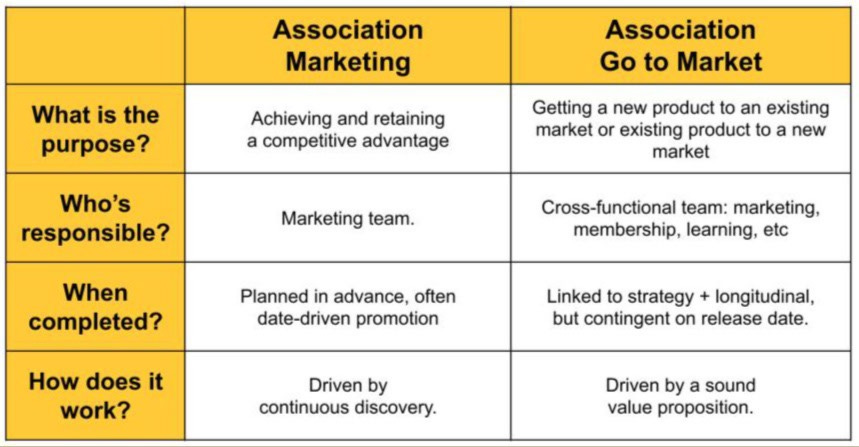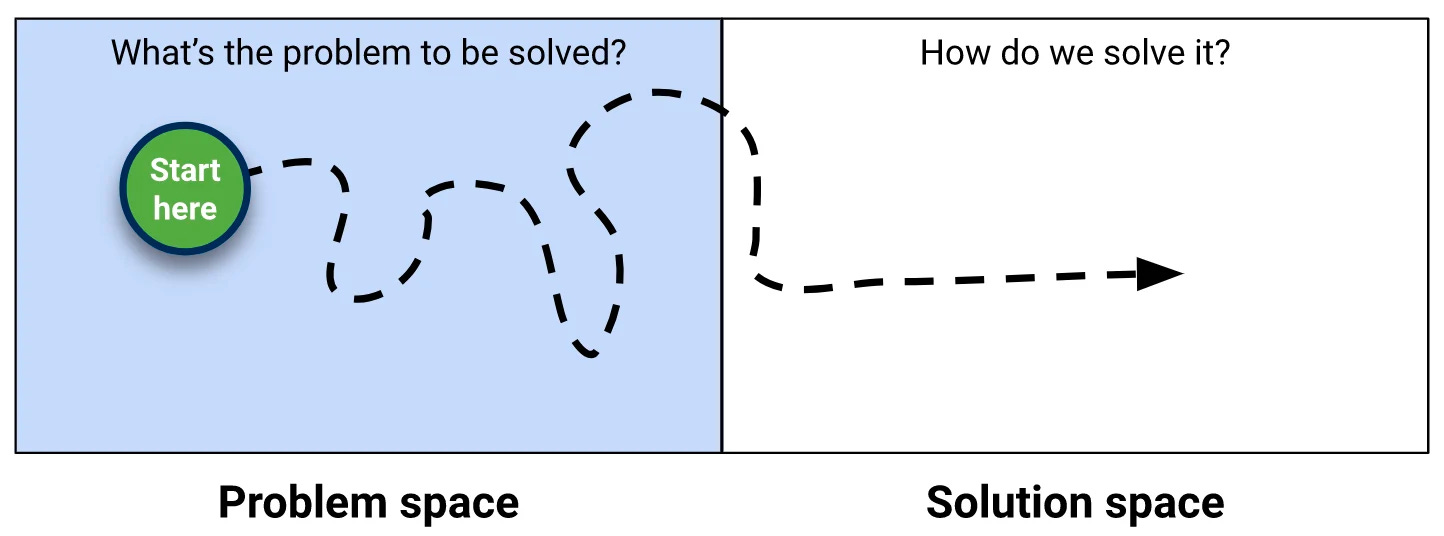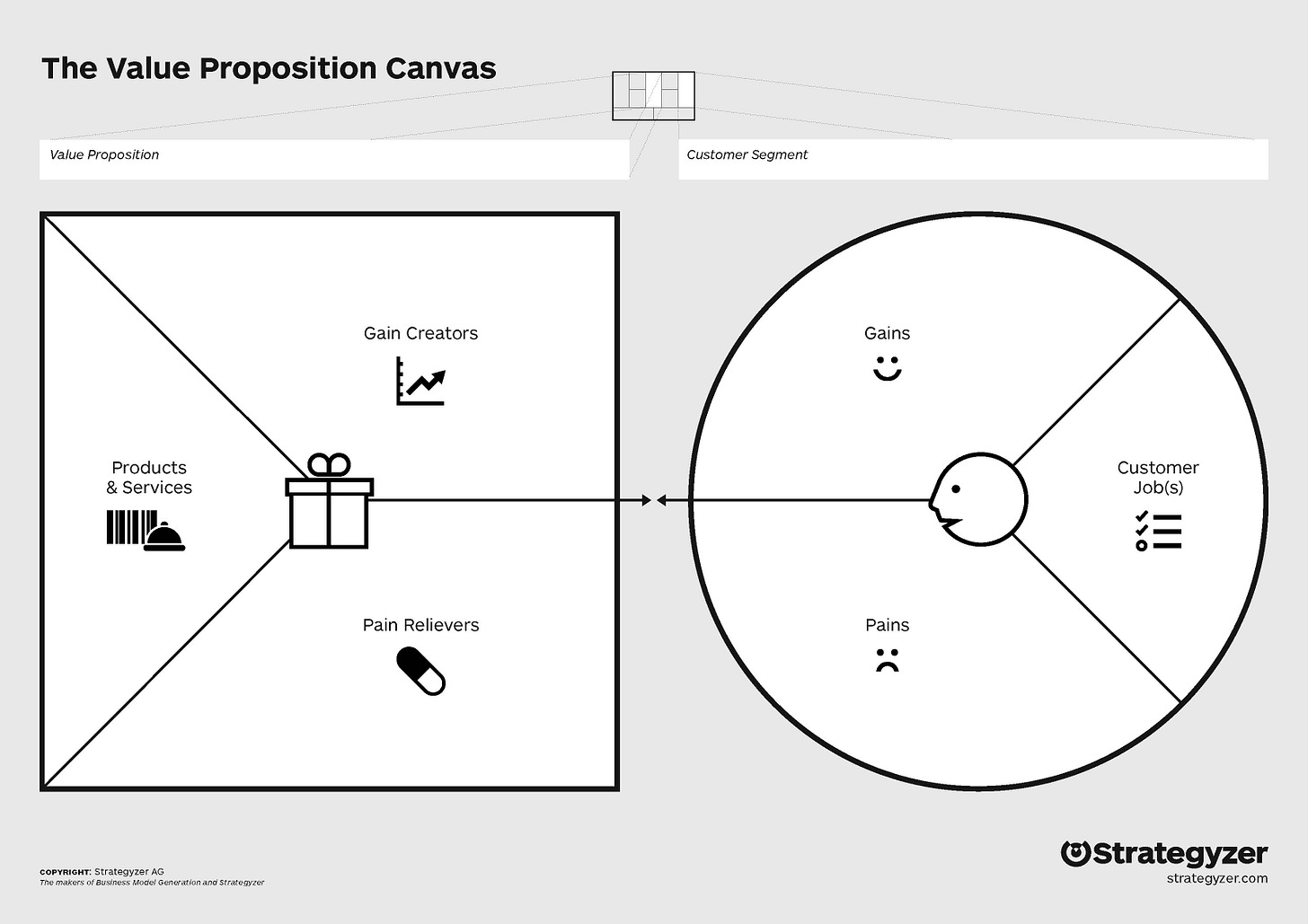Getting New Association Products to Market
Being Strategic About Growing Revenue and Reaching New Markets
Summary
This article provides an overview of go to market (GTM), one of six integrative association product competencies; the other five are: culture, vision, customer, design + build, and performance.
In doing so, we define GTM and frame its importance, distinguish between the problem space and the solution space, define and talk about the importance of creating a value proposition, address when GTM is appropriate, and provide practical insight on implementing GTM at your association.
The Product Community is a product development learning community designed specifically for associations.
Defining Go to Market
Associations are in the business of community building, member engagement, value creation and delivery.
They tend not to be practiced at designing and executing go to market strategies for distilling and getting new value to market in order to consistently reach and connect with members.
A go-to-market (GTM) strategy details how an association engages and convinces members to buy their product, program, event, etc.
GTM is much more than a promotional campaign for an annual meeting, upcoming webinar, or new course offering; it’s an investment in creating and communicating clear value in order to connect meaningfully, relentlessly, and continually.
It is designed to connect, communicate value, and ultimately for our associations to gain competitive advantage and to maximize our imprint on the market.
From deep connection comes consistent buying.
It takes a little practice to get GTM, but it is definitely something associations can learn and build upon with existing staff resources. This is especially important as, over time, the process of GTM can be socialized across your association’s portfolio (creating interdependencies and efficiencies in the process).
In learning GTM, we can deepen our knowledge about our membership communities, gain insight into new markets, and improve (and make more efficient) our ability for new products to meaningfully take hold in the market.
A GTM strategy can include varied activities such as: pricing, sales or distribution channels, or buyer’s journeys.
GTM requires focused branding, consistent messaging, and persistent discovery and outreach. For instance, an association might use an influencer campaign – creating anticipation and typically driven by social media – to create momentum and buzz.
However, for the purposes of this article (which is by no means exhaustive) we will focus on the following:
Defining your member / customer problem space.
Anchoring your offerings with a member-centric value proposition.
Addressing when to employ GTM.
Providing practical insight on implementing GTM at your association.
Though related, GTM can easily be confused with creating and executing a marketing plan. They are different yet complement each other in four key ways:
The Problem Space + The Solution Space
A vital foundation to creating an association GTM strategy is understanding the distinction between the problem space and the solution space.
New product development should always start with clearly defining the problem. For associations, this typically means deeply and clearly understanding our community’s needs.
It means empathizing and seeing the world from our member’s perspective (consistently and sustainably).
What is the problem to be solved? These can be expressed as pain points, desires, jobs to be done, or user stories.
Once the problem space is soundly defined, the product is built in the solution space.
The process of building a particular solution suggests some explicit decisions. This involves determining how the product looks, what it does, and how it works.
Associations often, unfortunately, start in the solution space and hope the what we build solves the problems of our community.
Not nearly enough attention is paid to identifying and defining the problem space. This can lead to developing products or experiences that fail to address an underserved need. It can lead to creating solutions for solution’s sake.
This is true because navigating the solution space is easier than understanding the problem space. In associations, we conversant with the solution space:
How to plan and build events
How to publish journals or write newsletters
Build and deliver courses
Synthesize and distribute trends
Navigating the problem space is trickier. It often involves market studies, analysis of external trends or forces, stakeholder interviews, empathy maps, customer profiles, persona development, or surveys.
The problem, unfortunately, is that in associations members often don’t know what they want or need (or simply can’t express it well enough for it to be useful).
One possible solution may seem somewhat counterintuitive. It starts with building a value proposition and continually engaging with and testing new products on and with the market.
Developing a Value Proposition
A value proposition is a promise of value to the customer or member.
They are powerful as they distill our customer’s wants, needs, or pains and provides powerful insight on what to build and how to deliver it.
The most well-known approach to creating a value proposition is the Value Proposition Canvas created by Strategyzer. It utilizes a customer profile and a corresponding value map.
Customer Profile Elements:
Customer Jobs – What jobs are our customers trying to accomplish? These are functional, social, or emotional. The jobs to be done framework suits this block well.
Pains – What are the potential bad outcomes of the customer job? What risks are associated with the jobs and what obstacles prevent customers from performing them?
Gains – What outcomes do our customers want to achieve, or what concrete benefits are they seeking from performing their jobs?
Value Map Elements:
Products & Services – Around what product and services is our value proposition built? What unique attributes does your product have?
Pain Relievers – How does our product reduce or eliminate customer pain?
Gain Creators – How does our product or service help our customers achieve their desired gains? How does it boost the final benefit they get?
Once the value proposition canvas is complete, we can prioritize the most important and least important jobs, pains, gains, attributes, relievers, and gain creators.
As we can’t satisfy all customer needs, we need to focus. What customer jobs do we want to target? What pains and gains are most critical for these jobs?
With a prioritized customer profile, we can refine our value map, eliminating everything that doesn’t target the gain and pains we have just defined.
This way, we build a specific value proposition that targets particular problems rather than trying to satisfy everything.
To summarize: Value Proposition = Gain Creators + Pain Relievers matching customer Gains and Pains.
We now transition to the importance of determining under what conditions we need a GTM strategy. This is important to positioning our associations for growth.
When Do Associations Need a GTM Strategy?
Despite their diversity, when looking to bring new products to market in order scale or grow, most associations adopt the following four market strategies (preferably a combination).
As we’ve discussed in previous articles, getting a new product to market for associations generally requires leveraging existing products: event, content stream (journals, newsletters, podcasts, etc.), or courses (webinars, workshops, institutes, training, etc.).
GTM can be used for new product or service launches, product rebranding, or product introduction to a new market.
All of the following strategies assume some market planning, but not every one requires a full-scale GTM strategy:
Penetration. Your association wants to sell more existing products to your primary membership. You are familiar with your community, so the risks are fairly low. However, your ability to grow within the bounds of the existing market can be limited. You should prepare a new marketing strategy and marketing plan to widen your reach.
Expansion. You want to introduce new products to your existing community. To succeed and minimize the risks of failure, you will need to study the market potential carefully. It’s worth creating a comprehensive marketing strategy, GTM strategy, and accompanying marketing plan.
Innovation. Are you planning to sell existing products to a new market? You will have to carefully weigh the pains, gains, and value of this new offer you will develop and distribute. You will need a marketing strategy, GTM, and marketing plan.
Aggression. Are you entering new markets with new products? An aggressive growth strategy assumes high risks and potentially high rewards for associations. This takes investment in understanding the new market including a sound value proposition and the best way to deliver the product.
Delivering on the Promise
Once we have a sound understanding of GTM, problem space vs. solution space, value proposition, and when to deploy a GTM strategy, we can put the wheels into motion.
As we have discussed, a key part of successfully building and delivering a new association product is an aggressive, efficient, and well-designed GTM strategy.
GTM plus the other association product competencies serve as an engine for the product community, which has the potential to drive a larger yet focused narrative to help propel associations to the forefront of innovation.
We can build new products while satisfying our mission and delivering on our vision. Employing GTM can also help position our associations for unprecedented visibility and impact.
With demonstrated visibility, impact, and a long-term sustainable strategy, associations can use this attention to expand resources and identify and find funding sources and sponsorship to support product evolution.
It can’t do any of these things without a solid and repeatable GTM strategy.
Not only does a GTM strategy help clarify the intentions of a particular product or program, it forces focus and can be tailored specifically to solving a customer’s pain points.
The bones of the GTM strategy reaches far beyond promotion or a marketing campaign.
GTM requires focused branding, consistent messaging, and persistent discovery and outreach. For instance, an association might use an influencer campaign – creating anticipation and typically driven by social media – to create momentum and buzz.
This isn't nearly enough and would need to be part of a larger, integrated, and longitudinal campaign for connection.
A Continuous, Ongoing Process
Conceptually, on its face, GTM is something that associations do all time (creating a three year running cycle for annual meeting, developing a publishing schedule for a quarterly publication, or planning ahead for the next webinar series).
However, given the focus on productization and creating usable customer pathways, GTM is quite different. Utilizing tools like pathway design, buyer’s journey, story development, or ideal customer personas can help.
As Holly Hester-Reilly says: “product-market fit isn’t a “big bang” event. It’s a series of events that happen as you identify your target, grow and diversify your market segments, the number of problems addressed, and the value of outcomes reached as your product develops over time”.
There are a number of things to unpack here that go beyond standard association event promotion:
GTM is intimately linked to continuous discovery.
GTM is sustained and longitudinal in nature.
GTM moves beyond email blasts to your membership list.
GTM is about empathizing with your members’ pain points and serving them value to alleviate them.
GTM is only one of the six association product competencies and, therefore, should never be treated in isolation. In some ways, the association competencies together – culture, vision, customer, design + build, go to market, and performance – unite as go to market!
Think of your GTM plan as an integrated, longitudinal engagement strategy that focuses your association on value creation and, ultimately, product-led growth.
At its core, product-led growth (PLG) is about leveraging the value you create for your association to acquire, activate, convert, and retain members.
It’s about monetizing engagement in a way that leverages proven value, fosters engagement, and creates a longitudinal connection.
This way, monetization is not transacting or squeezing your membership for more money. It’s creating and delivering an undeniably, indispensable experience.
From value conversation comes a robust connection. In turn, this robust connection drives membership numbers.
In PLG, your product is much more than a set of features that solve member pain points but also your GTM, distribution, and engagement fully integrated and in motion.
If done right, PLG is proven to have broader reach within your current member and, if focused enough, a credible vehicle to identify and reach customers outside your bread and butter core membership.
Remember, product-led growth fuels connection.
Join the product community and flip your destiny.
About the Author
James Young is founder and chief learning officer of the product community®. Jim is an engaging trainer and leading thinker in the worlds of associations, learning communities, and product development. Prior to starting the product community®, Jim served as Chief Learning Officer at both the American College of Chest Physicians and the Society of College and University Planning.
Please contact me for a conversation: james@productcommunity.us.






